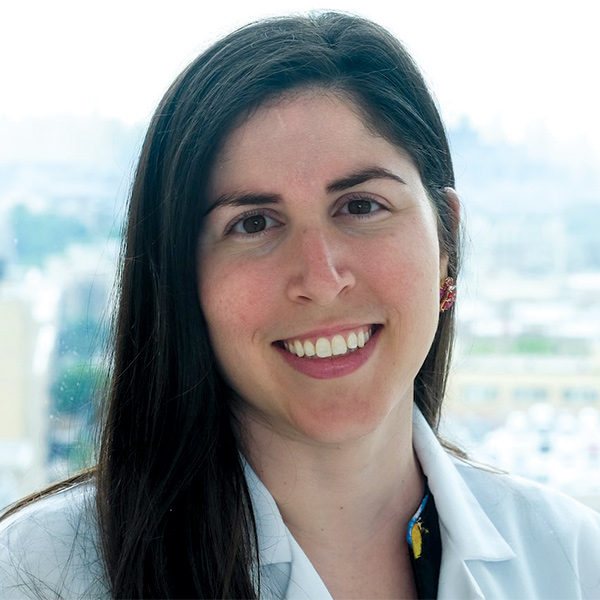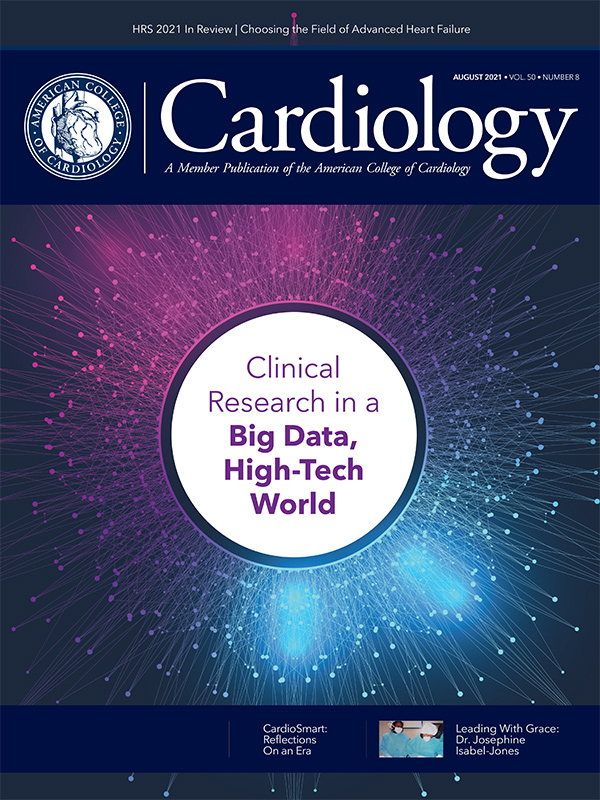For the FITs | Bringing the Advances to Advanced Heart Failure

When I entered my residency in internal medicine at Brigham and Women's Hospital in Boston, I thought I was going to be a gastroenterologist. I wanted to focus my clinical and research efforts in inflammatory bowel disease, because I was drawn to the longitudinal relationships with patients and the chronic disease model.
In the fall of my intern year, while rotating on our advanced heart failure service with Eldrin F. Lewis MD, MPH, FACC, I connected with a middle-aged gentleman with long-standing ischemic cardiomyopathy. He had become inotrope-dependent and needed a left ventricular assist device (LVAD) for destination therapy. At the time, I had never even heard of an LVAD. He was an engineer for many years and had been working up until that recent decompensation. Circuits were his livelihood, a closed loop through which current moved from one electrode to another, analogous in many ways to the way blood circulates in our body. After his surgery, he was able to return to doing the things that gave him pleasure such as spending time with his grandchildren and playing golf. I was struck by how this therapy had changed the trajectory of his disease.
The next year, I cared for a young woman with hypertrophic cardiomyopathy (HCM). She and I were around the same age, yet I was in the white coat and she was in the hospital bed with a pulmonary artery catheter in her neck waiting for a heart transplant. I still remember when we got the call that a heart had been accepted for her and the look on her face when we shared the news.
After those experiences, I was certain that not only did I want to be a cardiologist, but I specifically wanted to enter the field of advanced heart failure and transplant cardiology (AHFTC). Additionally, as a woman in this field, I have felt particularly at home. Women have played integral roles in the founding, recognition and development of the field of AHFTC.1 Sharon A. Hunt, MD, MACC, has postulated this may have contributed to the greater representation of women in this area, with up to 26-36% of trainees in AHFTC training programs being women, significantly higher than the representation in more procedural specialties.
Medical Miracles: Changing the Trajectory in HF
As I continued through my general cardiology fellowship and embarked on my AHFTC training, I recognized these interventions as medical miracles for our patients. As Michelle M. Kittleson, MD, PhD, FACC, once wrote, "I am honored to watch patients as they are snatched from the jaws of death, transformed by the miracle of a donor heart… It's such a rare and beautiful privilege to see something work that shouldn't."2
Yet, I have also grown to appreciate the less dramatic but still momentous victories: the patient started on sacubitril-valsartan who reports improving exercise tolerance; the patient with a CardioMEMS who previously had recurrent hospitalizations and is able to stay out of the hospital for a year; or the patient with new-onset HF whose LV ejection fraction has improved on medications and does not need an ICD.
These moments have been made possible by medical advances and new treatments available even in just the last few years. For patients with HF with reduced ejection fraction, the SGLT2 inhibitor class of drugs has shown significant mortality benefit and reduction in HF hospitalization regardless of the presence or absence of diabetes.3,4 This drug class is a pillar of quadruple therapy in HF and it is anticipated to receive a Class I recommendation in the next update of the HF guideline. In the VICTORIA trial, vericiguat was shown to be superior to placebo in reducing HF hospitalization via a novel mechanism, namely an oral soluble guanylate cyclase stimulator.5
These therapeutic developments also have extended to patients with other cardiomyopathies and HF with preserved ejection fraction (HFpEF).
Transthyretin cardiac amyloidosis has become increasingly common without effective disease-modifying therapies. However, in 2018, the ATTR-ACT study demonstrated that tafamadis, a stabilizer of the amyloid protein, significantly reduced overall mortality and annual cardiovascular hospitalizations.6 Tafamadis also has been shown to improve HF-related quality of life and functional status. This has encouraged the HF community to be more aggressive about diagnosing this condition early, with the hope of modifying the disease course. Similarly, in HCM, the EXPLORER-HCM trial demonstrated that mavacamten improved exercise capacity, reduced obstruction and improved NYHA functional class.7 By understanding the pathophysiology underlying these cardiomyopathies, these therapies are meant to be disease-specific rather than just treating the symptoms of the disease.
Perhaps most anticipated are the full results of the EMPEROR-Preserved study, scheduled to be presented at ESC Congress 2021, after the recent announcement that the SGLT2 inhibitor empagliflozin met its primary endpoint of reducing the risk of HF hospitalization and cardiovascular death in patients with chronic HFpEF.
With respect to advanced HF therapies, the LVAD and heart transplant landscape has changed since my residency. The LVAD technology has evolved even since my patient who first kindled my interest in HF underwent surgery six years ago. The HeartMate 3 pump continues to have excellent long-term outcomes with lower adverse event rates, and the possibility for reduced anticoagulation.8 In the area of heart transplantation, there are various new technologies for organ preservation and procurement including donation after circulatory death that are being used and studied to expand the donor pool. Additionally, the use of hearts from Hepatitis C-virus positive donors has significantly expanded the donor opportunities available to candidates on the waitlist.
This is not to say these treatments are always readily available to our patients. Significant barriers remain in access to care whether because of insurance coverage, financial costs or social determinants of health. Disparities in care have become increasingly apparent because of the COVID-19 pandemic. However, the arsenal of therapies continues to expand. We still have a lot of work to do to make sure the expansion is equitable.
I'm also not presuming that all our patients will respond as we wish to these therapies. There will be those who are unable to tolerate neurohormonal blockade due to hypotension or other symptoms. There will be others who will not be candidates for advanced therapies due to medical contraindications or comorbidities. Nonetheless, we will still have the honor and privilege of caring for them and following them on the ups and downs of their journey with HF.
Ever since those fateful days during my internal medicine residency, I've never once regretted my decision to become an AHFTC cardiologist. The HF community is one with an inquisitive mind and a dedication to patient care. It's an exciting time to come and join us.
Learn more and get involved with the FIT and the Heart Failure and Transplant Member Sections. Visit ACC.org/Membership to get started.

Meet Our FIT Section Editor
This article was written by Ersilia M. DeFilippis, MD, a fellow in training in advanced heart failure and transplant cardiology at Columbia University Irving Medical Center (CUIMC) in New York. She earned her Bachelor of Arts in Women's, Gender and Sexuality Studies with a focus in Women's Health at Yale University and her medical degree from Weill Cornell Medical College. After completing her internship and residency at Brigham and Women's Hospital in Boston, MA, DeFilippis joined CUIMC where she completed her fellowship in cardiovascular disease. She is on the editorial board of JACC: Heart Failure, European Journal of Heart Failure and Cardiac Failure Reviews. She has written over 140 peer-reviewed manuscripts, with first author publications in JACC, Circulation, JAMA Cardiology and European Heart Journal. She also enjoys writing narrative medicine.
Do you have an idea for an article for this section? Want to write an article? Reach out to DeFilippis via Twitter @ersied727 or email cardiologyeditor@acc.org.
The DeFilippis File: Fast Facts
In her "spare" time, Ersilia M. DeFilippis, MD, is also the FIT Section Editor. She shared more about her accomplishments with Cardiology and offers advice for other FITs.
First published paper
A case report in 2013 in Clinical Imaging of a woman in whom sarcoidosis was diagnosed during evaluation for breast cancer.
Most recent published paper
Last month, an article in JACC looking at the need for sex-specific guidelines in cardiovascular disease.Other published articles
Articles in the New York Times on patients who leave against medical advice; the hospital gown; and talking to children when a patient is dying. An article on celebrating Christmas in the time of COVID published in the Washington Post.
Impact of the COVID-19 pandemic on delivering cardiovascular care
The COVID-19 pandemic has really highlighted for me the need for holistic care for our patients with an eye towards the impact of psychological and emotional well-being in addition to physical health. This is intricately tied to social determinants of health and has further spurred my interest in disparities in advanced heart failure therapies.
Research interests
Sex differences in heart failure management and outcomes; intersection of pregnancy and heart failure; decision making and selection for advanced heart failure therapies.
Clinical interests
Heart transplantation; disparities in care; cardio-obstetrics.
#1 Tip for FITs
Keep your mind open to new possibilities. I went into residency thinking I was going to do gastroenterology and here I am!
Favorite hack for better patient care
Every day, I try to learn something nonmedical about my patients, e.g., what books they like to read or how many grandchildren they have.
Keys for well-being and finding balance
Surround yourself with friends and family who support you.
Life beyond medicine
I played competitive tennis in college. Now I try to play on weekends when I can. I also like to read fiction and do jigsaw puzzles.
References
- DeFilippis EM, Moayedi Y, Reza N. Representation of women physicians in heart failure clinical practice. Card Fail Rev 2021;7:e05.
- Kittleson MM. The 1% Club. JAMA Cardiol 2017;2:13.
- McMurray JJV, Solomon SD, Inzucchi SE, et al. Dapagliflozin in Patients with heart failure and reduced ejection fraction. N Engl J Med 2019;381:1995-2008.
- Packer M, Anker SD, Butler J, et al. Cardiovascular and renal outcomes with empagliflozin in heart failure. N Engl J Med 2020;383:1413-24.
- Armstrong PW, Pieske B, Anstrom KJ, et al; VICTORIA Study Group. Vericiguat in patients with heart failure and reduced ejection fraction. N Engl J Med 2020;382:1883-93.
- Maurer MS, Schwartz JH, Gundapaneni B, et al; ATTR-ACT Study Investigators. Tafamidis treatment for patients with transthyretin amyloid cardiomyopathy. N Engl J Med 2018;379:1007-16.
- Olivotto I, Oreziak A, Barriales-Villa R, et al. Mavacamten for treatment of symptomatic obstructive hypertrophic cardiomyopathy (EXPLORER-HCM): a randomised, double-blind, placebo-controlled, phase 3 trial. Lancet 2020;396:759-69.
- Mehra MR, Goldstein DJ, Uriel N, et al; MOMENTUM 3 Investigators. Two-Year outcomes with a magnetically levitated cardiac pump in heart failure. N Engl J Med 2018;378:1386-95.
Clinical Topics: Anticoagulation Management, Cardiac Surgery, COVID-19 Hub, Heart Failure and Cardiomyopathies, Invasive Cardiovascular Angiography and Intervention, Aortic Surgery, Cardiac Surgery and Heart Failure, Acute Heart Failure, Heart Transplant, Mechanical Circulatory Support, Interventions and Structural Heart Disease
Keywords: ACC Publications, Cardiology Magazine, Middle Aged, Quality of Life, Exercise Tolerance, Hepacivirus, Prealbumin, Heart Failure, Heart Transplantation, Heart-Assist Devices, Organ Preservation, Fellowships and Scholarships, Stroke Volume, Internship and Residency, COVID-19, SARS-CoV-2, Pulmonary Artery, Social Determinants of Health, Tissue Donors, Cardiomyopathies, Cardiomyopathy, Hypertrophic, Cardiology, Hospitalization, Internal Medicine, Diabetes Mellitus, Hypotension, Chronic Disease, Amyloidosis, Technology, Hospitals, Inflammatory Bowel Diseases, Insurance Coverage, Electrodes, Anticoagulants, Health Services Accessibility, Patient Care, Catheters, Innovation
< Back to Listings

